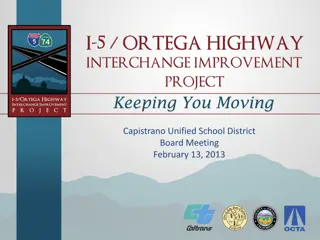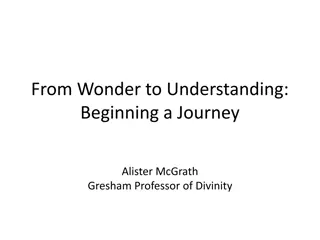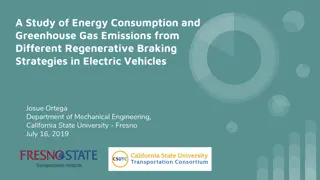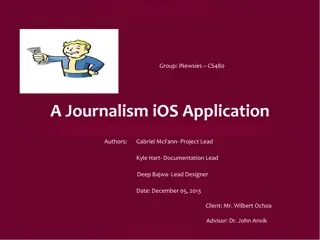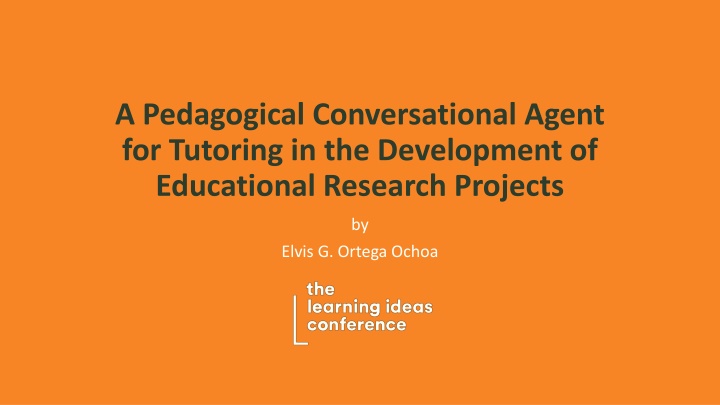
Pedagogical Conversational Agent for Educational Research Projects
Explore the development of a pedagogical conversational agent for tutoring in educational research projects by Elvis G. Ortega Ochoa. The project focuses on the student-teacher ratio in vocational training programs, addressing the lack of connection between systems and tutoring approaches. Discover the aim to determine the algorithm of the PCA dialogic system for tutoring in basic education career at UNAE during the academic period.
Download Presentation

Please find below an Image/Link to download the presentation.
The content on the website is provided AS IS for your information and personal use only. It may not be sold, licensed, or shared on other websites without obtaining consent from the author. If you encounter any issues during the download, it is possible that the publisher has removed the file from their server.
You are allowed to download the files provided on this website for personal or commercial use, subject to the condition that they are used lawfully. All files are the property of their respective owners.
The content on the website is provided AS IS for your information and personal use only. It may not be sold, licensed, or shared on other websites without obtaining consent from the author.
E N D
Presentation Transcript
A Pedagogical Conversational Agent for Tutoring in the Development of Educational Research Projects by Elvis G. Ortega Ochoa
Student-Teacher Ratio Student-teacher ratio in vocational training programs [10]: 13:1
Research Problem Research lack: connection of these systems with tutoring of educational research projects + a comprehensive approach through the mixed method [5, 8, 12, 16]. The dialogue mediated by ICT must activate the teaching and learning process [6, 11, 15]. Based on research Based on practice
Review of Relevant Scholarship Intentions and entities [2]. Design, Integration, and Evaluation Methodology (MEDIE) [12]. Conversations with AutoTutor Help Students Learn [5]. Pedagogic Conversational Agent dialogue management to learn how to program [8]. PCA dialogic system Tutoring the PIENSA PCA dialogic system for tutoring the PIENSA No previous research
Study Objective Determine the algorithm of the PCA dialogic system for tutoring the PIENSA in the Basic Education Career, distance learning, at the UNAE, academic period semester I (SI) 2021.
Pragmatism Mixed methods research (MMR) [3, 13, 14]. The study was descriptive scope, cross-sectional, and empirical.
Mixed Method Light Convergent design, questionnaire variant. Fig. 1. Procedural Diagram of the Convergent Design, Questionnaire Variant.
Population Students of the Professional Training Unit of the Basic Education Career, distance learning, at the UNAE, academic period SI 2021. N = 1,124
Participant Recruitment The sample was identical for the two approaches; it was selected with the one-stage cluster sampling technique and Simple Random Sampling [4, 7]. 287 Confidence level = 95%. Estimated sampling error = 5 %. students (Men = 122, Women = 194) A pilot test was applied to one hundred of the 316 participants.
Data Collection and Analysis Questionnaire Sections: role, general, and specific functions [8, 12]. Horizontal mixed analysis Data analysis and interpretation were developed using [9]: 1. Descriptive statistics (IBM SPSS Statistics) 2. Content analysis (NVivo) Characteristics: 1. Voluntary 2. Electronic 3. Synchronous and asynchronous accompaniment
Validity, Reliability, and Methodological Integrity Instrument validity [1]: positive consequences. Instrument reliability [4]: pilot test (response rate = 53.06 %). The ethical decision-making approach was to establish rules and assume the risk that a detailed explanation might distort the participants responses.
Response Rate Final administration response rate = 53.21 %. Equation for response rate calculation: ?????? ???????? ? 100 % ? ?? ?????? (?????????? + ?????? ????)
Quantitative Analysis (1/2) General Functions of the PCA Dialogic System. Fig. 2. Students Preferences About the General Functions of the PCA Dialogic System.
Quantitative Analysis (2/2) Role and specific functions of the PCA Dialogic System. PCA should have the role of teacher/tutor (65.8 %). When they are not attentive to the development orientations of the PIENSA, the PCA should tell them that it is going to contact the teaching staff (45 %), advise them to study more (45 %), and indicate that if they do not study, they will fail (40.3 %). When they do not understand the activity indications, the PCA should mainly explain in detail all the steps to be developed (61.7 %).
Qualitative Analysis (1/3) Dialogic simulation has 313 interventions: Students 159 (50.8 %) PCA 154 (49.2 %) The categories established were six, which encompass the student and PCA dialogues.
Table 1. Categories and Subcategories of the Chat Log Between Students and the PCA. f (%) Categories and subcategories Student PCA Dialogue topic (intention) 1. Activities methodological orientations 2. Appreciation/Motivation 3. General course guidelines 4. Activity resources 5. Educational Research 6. Learning Management System Technical Support 7. Connectivity problems 8. Technological applications 9. Standards of the American Psychological Association 10. Activity evaluations Knowledge level Low (less than 5 words) Medium (between 5 and 15 words) Dialogue length Short (less than 10 words) Medium (between 10 and 20 words) Long (more than 20 words) Questions, spelling, and grammar No questions One question Low (less than 2 spelling errors) Medium (between 2 and 5 spelling errors) Low (less than 2 grammar errors) Medium (between 2 and 5 grammar errors) 41 (25.8) 33 (20.8) 28 (17.6) 25 (15.7) 19 (11.9) 9 (5.7) 1 (.6) 1 (.6) 1 (.6) 1 (.6) 28 (18.2) 22 (14.3) 30 (19.5) 58 (37.7) 7 (4.5) 8 (5.2) - - - 1 (.6) 151 (95) 8 (5) 145 (94.2) 9 (5.8) 104 (65.4) 54 (34) 1 (.6) 90 (58.4) 60 (39) 4 (2.6) 119 (74.8) 40 (25.2) 138 (86.8) 21 (13.2) 150 (94.3) 9 (5.7) - - - - - -
Qualitative Analysis (3/3) PCA: remember that we are about to deliver the first draft of PIENSA. Intention (I) = 3 S: I have difficulties in the development of activity 4.6 that allows me to develop my theoretical framework. I = 5 PCA: you can find relevant information on your topic at the following links. I = 4 S: excellent, the links are adequate and will help me to improve and complete my project. I = 2 Fig. 3. Excerpt of the Chat Log Between the Students and PCA.
Meta-Inferences: Interpretation of Information (1/2) Convergence: the PCA is assumed with the role of teacher/tutor, characterized by offering motivation and identifying errors, including writing. Complementarity: the topic should be explained in detail, remember dialogues, and give recommendations. Correspond with the knowledge level, if applicable, to promote higher cognitive processes, correspond in dialogue length with that of the student, and in case of inattention, apply the respective functions.
Fig. 4. Flowchart of the Algorithm of the PCA Dialogic System for Tutoring the PIENSA.
Conclusions (1/2) The most noteworthy aspect was to analyze the PCA dialog flow for tutoring in the development of educational research projects. 1. The results indicated general and specific functions, and the role, that is, pedagogical and social criteria of PCA [11]. 2. The algorithm of the PCA dialogic system should have the teacher/tutor s role, offer emotional support, identify errors in the dialogue topics, and so forth. What most supported the research was to unify, adapt, and validate the questionnaire [8, 12].
Conclusions (2/2) Relevance and usefulness 1. The research linked the PCA dialogic system with the PIENSA tutoring, and the results were generated from an integrative and pragmatic approach. 2. The study focused on the needs of the students and had a proposal of the algorithm for tutoring personalization. Limitations and future research 1. The electronic survey is not the best alternative to have a higher response rate. 2. Data from the dialogic simulation are few to determine the behavior. 3. Algorithm validation with the students.
References (1/4) 1. American Educational Research Association, American Psychological Association, National Council on Measurement in Education.: The Standards for Educational and Psychological Testing. American Educational Research Association, Washington (2014). 2. Clark, A., Fox, C., Lappin, S. (Eds.): The Handbook of Computational Linguistics and Natural Language Processing. John Wiley & Sons, Inc, Chichester (2010). https://doi.org/10.1002/9781444324044 3. Creswell, J., Plano-Clark, V.: Designing and Conducting Mixed Methods Research. 3rd ed. SAGE Publications, Inc, Los ngeles (2018). 4. De Vaus, D.: Surveys in Social Research. 6th ed. Routledge, London (2013). https://doi.org/10.4324/9780203519196 5. Graesser, A.: Conversations with AutoTutor Help Students Learn. International Journal of Artificial Intelligence in Education 26(1), 124-132 (2016). https://doi.org/ghptnr
References (2/4) 6. Graesser, A., Li, H., Forsyth, C.: Learning by Communicating in Natural Language With Conversational Agents. Current Directions in Psychological Science 23(5), 374-380 (2014). https://doi.org/10.1177/0963721414540680 7. Kish, L.: Survey Sampling. John Wiley & Sons, Inc, New York (1965). 8. Oca a, J., Morales-Urrutia, E., P rez-Mar n, D., Tamayo, S.: Pedagogic Conversational Agent dialogue management to learn how to program (in Spanish). Iberian Journal of Information Systems and Technologies (E19), 239-251 (2019). http://www.risti.xyz/is-sues/ristie19.pdf 9. Onwuegbuzie, A., Johnson, B. (Eds.): The Routledge Reviewer s Guide to Mixed Methods Analysis. Routledge, New York (2021). https://doi.org/10.4324/9780203729434 10. Organisation for Economic Co-operation and Development.: Education at a Glance 2020: OECD Indicators. OECD Publishing, Paris (2020). https://doi.org/10.1787/69096873-en
References (3/4) 11. P rez-Mar n, D.: Review of the Practical Applications of Pedagogic Conversational Agents to Be Used in School and University Classrooms. Digital 2021 1, 18-33 (2021). https://doi.org/10.3390/digital1010002 12. Tamayo, S.: Methodology Proposal for the Design and Integration in the Classroom of a Pedagogical Conversational Agent from Secondary Education to Early Childhood Education (in Spanish) [Doctoral thesis, Rey Juan Carlos University]. Rey Juan Carlos University Institutional Repository, M stoles (2017). http://hdl.handle.net/10115/14691 13. Tashakkori, A., Johnson, B., Teddlie, C.: Foundations of Mixed Methods Research: Integrating Quantitative and Qualitative Approaches in the Social and Behavioral Sciences. 2nd ed. SAGE Publications, Inc, Thousand Oaks (2021). 14. Tashakkori, A., Teddlie, C. (Eds.): SAGE Handbook of Mixed Methods in Social & Behavioral Research. 2nd ed. SAGE Publications, Inc, Thousand Oaks (2010). https://dx.doi.org/10.4135/9781506335193
References (4/4) 14. Technical University of Manab .: Methodological instructions on knowledge integration projects (in Spanish). UTM, Portoviejo (2017). 15. Winkler, R., S llner, M.: Unleashing the Potential of Chatbots in Education: A State-Of-The-Art Analysis. In: Taneja, S. (Ed.) Academy of Management Annual Meeting, vol. 2018, p. 15903. AOM, Chicago (2018). https://doi.org/ghptjr
Credits elvisortegaec elvisortegaec @elvisortegaec elvisortegaec A Pedagogical Conversational Agent for Tutoring in the Development of Educational Research Projects by Elvis Gerardo Ortega Ochoa is licensed under a Creative Commons Attribution-ShareAlike 4.0 International License.

